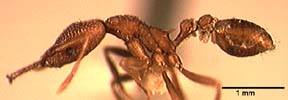
Specimen: Costa Rica, Prov. Heredia: La Selva Biological Station (J. Longino 1425). INBIOCRI001284019. Image by J. Longino.

Specimen: Costa Rica, Prov. Heredia: La Selva Biological Station (J. Longino 1425). INBIOCRI001284019. Image by J. Longino.
Dacetini, Myrmicinae, Formicidae, Hymenoptera, Insecta, Arthropoda, Animalia
John T. Longino, The Evergreen State College, Olympia WA 98505 USA. longinoj@evergreen.edu
24 July 1997
Specimen: Costa Rica, Prov. Heredia: La Selva Biological Station (J. Longino 1425). INBIOCRI001284019. Image by J. Longino. |
Specimen: Costa Rica, Prov. Heredia: La Selva Biological Station (J. Longino 1425). INBIOCRI001284019. Image by J. Longino. |
Identification
Apical fork of mandible with two intercalary teeth; mandible with two pronounced preapical teeth; eye large, with over 35 facets; dorsal and ventral teeth of propodeal lamella pronounced, acute; gaster finely longitudinally striolate, opaque-sericeous throughout.
Head length 0.96mm, mandible length 0.59, CI 75, MI 61 (n=1 holotype worker from Panama; Brown 1961).
Similar species: extirpa
Range
Panama, Costa Rica (Atlantic lowlands).
Natural History
Brown and Wilson (1959) summarize the genus as follows:
"Widespread in tropics and warm temperate areas. Primarily forest-dwelling; some species occur in grassland and arid scrub. ... Nests mostly in soil and rotting wood; a few species live in arboreal plant cavities in tropical rain forest. Foraging hypogaeic to epigaeic-arboreal. Food: most species are collembolan feeders; a few are polyphagous predators or occasionally feed on sugary substances..."
fairchildi is arboreal.
Selected Records
La Selva: canopy fogging sample.
La Selva: worker on Inga extrafloral nectary.
Literature Cited
Brown, W. L., Jr. 1961. The Neotropical species of the ant genus Strumigenys Fr. Smith: Miscellaneous concluding studies. Psyche 68:58-69.
Brown, W. L., Jr., Wilson, E. O. 1959. The evolution of the dacetine ants. Quarterly Review of Biology 34:278-294.